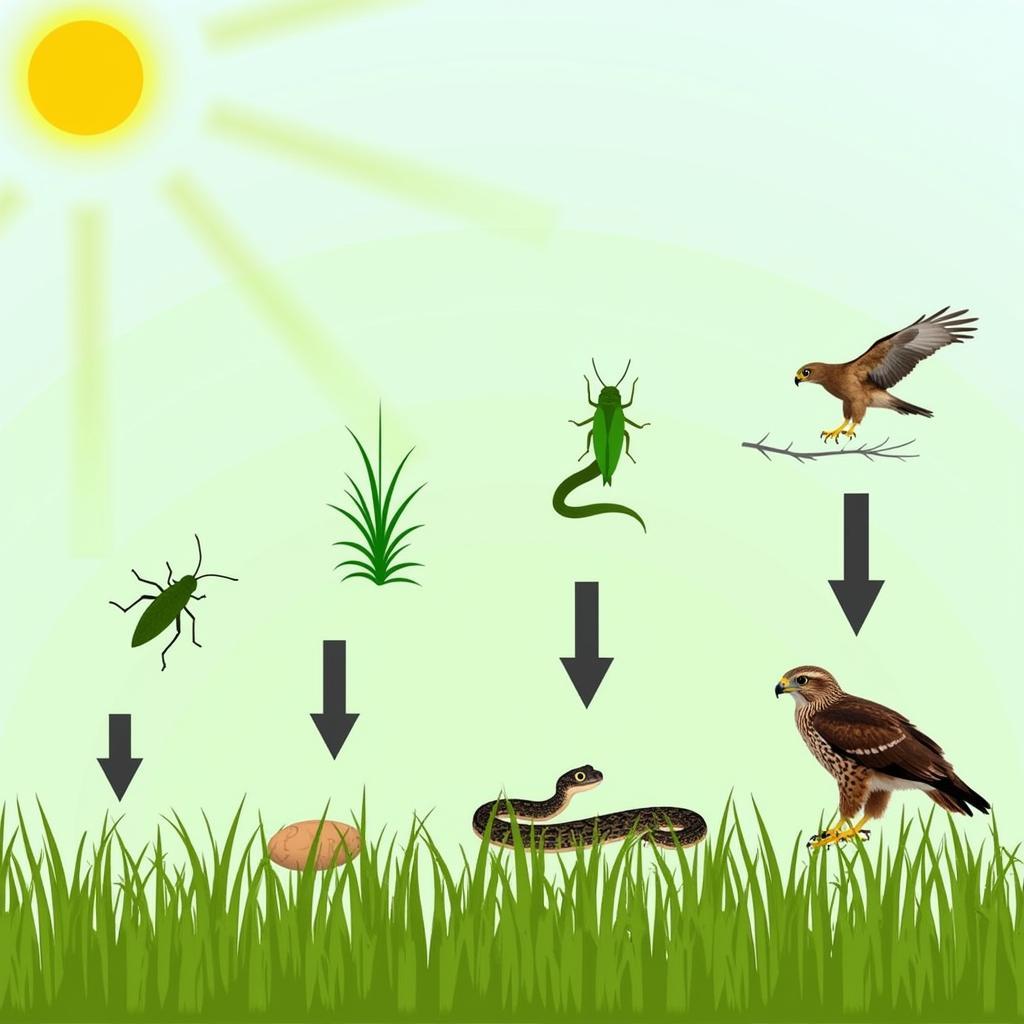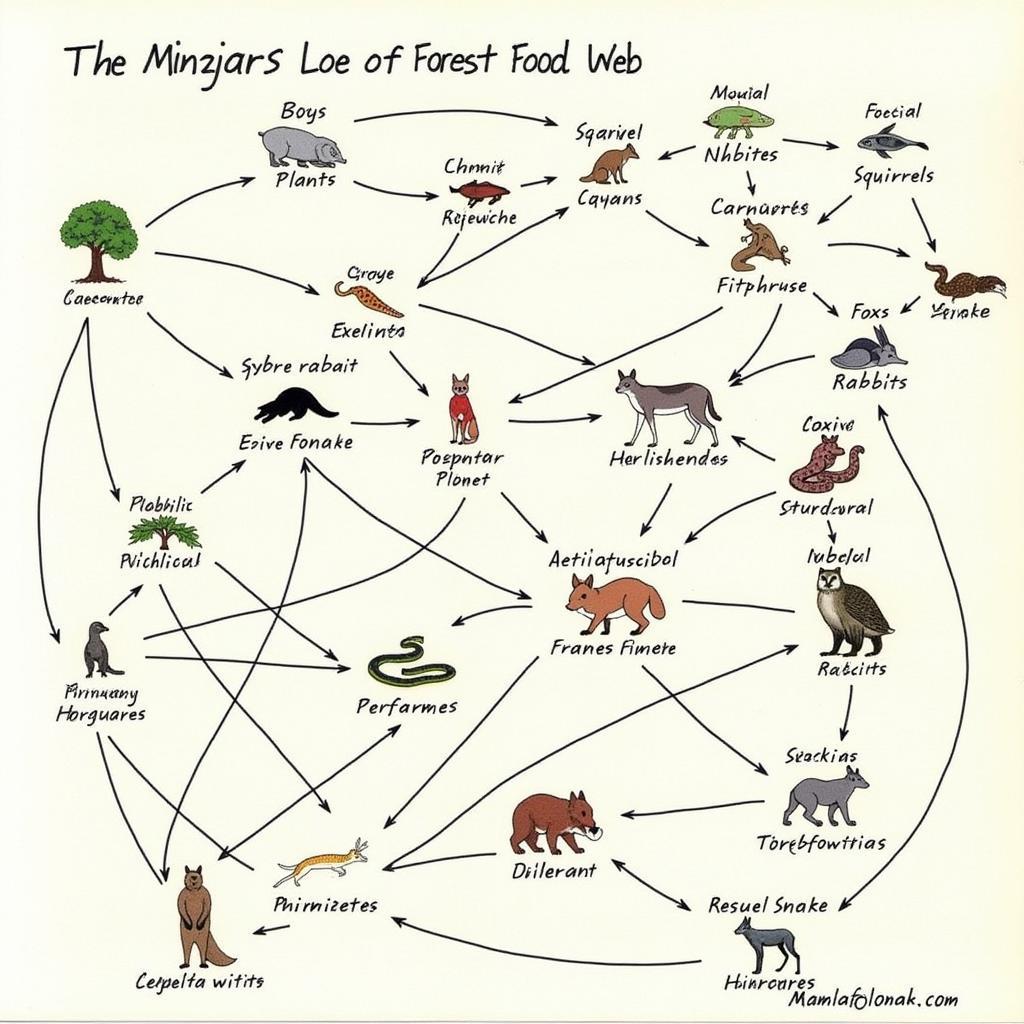Understanding food chains, food webs, and energy pyramids is crucial for grasping how energy flows through ecosystems. Whether you’re a student tackling a worksheet or simply curious about the natural world, this comprehensive guide will equip you with the knowledge you need to confidently navigate the intricate relationships between organisms. We’ll explore the key concepts, provide examples, and delve into common questions surrounding Food Chains Food Webs And Energy Pyramid Worksheet Answers.
Decoding the Food Chain: A Step-by-Step Energy Transfer
A food chain illustrates the linear transfer of energy from one organism to another. It begins with a producer, like a plant, which converts sunlight into energy through photosynthesis. Next comes the primary consumer, a herbivore that eats the plant. Then, a secondary consumer, a carnivore, eats the primary consumer. The chain continues with tertiary consumers and so on, until it reaches the apex predator, the organism at the top of the food chain. Each organism represents a trophic level, indicating its position in the energy transfer process.
For example, a simple food chain in a grassland ecosystem might be: grass (producer) -> grasshopper (primary consumer) -> snake (secondary consumer) -> hawk (tertiary consumer).
 Grassland Food Chain Diagram
Grassland Food Chain Diagram
Weaving the Web: Interconnected Food Chains
Food webs, on the other hand, represent the interconnectedness of multiple food chains within an ecosystem. They provide a more realistic picture of how organisms interact and consume each other. While a food chain shows a single pathway of energy flow, a food web showcases the diverse feeding relationships within a community.
Imagine a forest ecosystem. A rabbit might eat various plants, while a fox might prey on rabbits, squirrels, and even birds. These overlapping relationships create a complex web of energy transfer, highlighting the interdependence of species.
 Forest Food Web Diagram
Forest Food Web Diagram
Scaling the Energy Pyramid: Quantifying Energy Flow
An energy pyramid graphically represents the flow of energy through different trophic levels. The base of the pyramid represents the producers, containing the most energy. As you move up the pyramid, each level represents the next trophic level, with decreasing amounts of energy available. This is because only about 10% of the energy at one trophic level is transferred to the next. The rest is lost as heat or used for metabolic processes.
This explains why there are typically fewer apex predators than producers in an ecosystem – there simply isn’t enough energy available to support a large population of top-level consumers.
Food Chains Food Webs and Energy Pyramid Worksheet Answers: Common Questions
What are some common questions students encounter on worksheets about food chains, food webs, and energy pyramids? Let’s delve into some typical examples.
What is the difference between a food chain and a food web?
A food chain shows a single pathway of energy transfer, while a food web depicts the interconnectedness of multiple food chains within an ecosystem.
Why are decomposers important?
Decomposers, like bacteria and fungi, break down dead organisms and return essential nutrients to the soil, making these nutrients available for producers. This completes the cycle of energy flow in an ecosystem.
How does the energy pyramid demonstrate the 10% rule?
The decreasing size of each level in the energy pyramid visually represents the 10% rule, demonstrating how only a fraction of energy is transferred from one trophic level to the next.
“Understanding the interconnectedness of ecosystems through food webs is essential for effective conservation efforts,” says Dr. Emily Carter, a renowned ecologist specializing in trophic dynamics. “By recognizing the complex relationships between species, we can better protect biodiversity and ensure the health of our planet.”
 Energy Pyramid Diagram
Energy Pyramid Diagram
Conclusion: Connecting the Dots in the Ecosystem
Understanding food chains, food webs, and energy pyramids provides a vital framework for comprehending the flow of energy within ecosystems. By exploring food chains food webs and energy pyramid worksheet answers, we can gain a deeper appreciation for the intricate relationships that sustain life on Earth. This knowledge empowers us to make informed decisions about conservation and environmental stewardship.
FAQ
- What is the first trophic level in a food chain? Producers (plants).
- What is an example of a secondary consumer? A snake.
- Why is the energy pyramid shaped like a pyramid? It represents the decreasing amount of energy available at each trophic level.
- What do decomposers do? They break down dead organisms and return nutrients to the soil.
- What is the difference between a food chain and a food web? A food chain is a linear pathway, while a food web is a network of interconnected food chains.
- Why are apex predators important? They help regulate populations of prey species.
- What is the 10% rule? Only about 10% of energy at one trophic level is transferred to the next.
Interested in further exploring ecosystems? Check out our articles on biodiversity hotspots and the importance of ecological balance.
Need further assistance with understanding food chains, food webs, and energy pyramids? Please contact us. Phone: 02437655121, Email: minacones@gmail.com Or visit us at: 3PGH+8R9, ĐT70A, thôn Trung, Bắc Từ Liêm, Hà Nội, Việt Nam. We have a 24/7 customer service team.